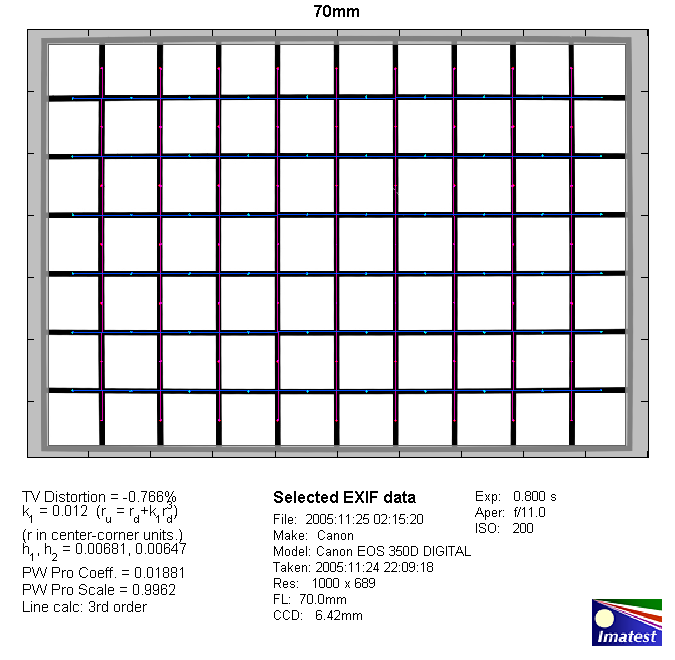|
Canon EF 70-300mm f/4-5.6 USM IS - APS-C Format Review / Retest - Analysis |
|
Lens Reviews -
Canon EOS (APS-C)
|
|
Page 2 of 2

Distortion
The Canon EF 70-300mm IS doesn't show any weakness across the range here. There's only a slight amount of barrel distortion at 70mm (0.7%) and slight pincushion distortion from 200-300mm (~0.7%). This is nothing to worry about in typical field conditions. Please note that the lens performs worse on full format DSLRs here.
|
Move the mouse cursor over the focal length text marks below to observe the respective distortion
|
| 70mm |
200mm |
300mm |

|
Note: we took advantage of the previously recorded distortion data. This characteristic cannot change just by using a higher mega-pixel camera of course.
Vignetting
Typical for most full format lenses used on APS-C DSLRs there's only a very slight amount of light fall-off even at max. aperture.

MTF (resolution)
We were quite baffled about the resolution characteristic of the lens in our initial test and it continued to convince us during the retest again. The results are very good across the range at 70mm and the center does even peek over the excellent barrier at medium aperture settings. There's a slight drop at 200mm but the quality remain very high. The 300mm sees a further decrease but it's still well above average for a lens in this price class.
The results are generally damped compared to our initial test but that's no surprise regarding the difference in resolution between the base DSLRs used for testing.
Please note that the MTF results are not directly comparable across the different systems!
Below is a simplified summary of the formal findings. The chart shows line widths per picture height (LW/PH) which can be taken as a measure for sharpness.
If you want to know more about the MTF50 figures you may check out the corresponding Imatest Explanations
Chromatic Aberrations
Lateral CAs (color shadows at hard contrast transitions) are very low in the 70mm to 200mm range. The situations changes a bit at the extreme long end where the issues exceeds 1.2px on the average at the image borders. This is, by no means, extreme but it can be noticed at times in critical situations.

Sample Images
You may check out our initial test of the lens.
Verdict
The Canon EF 70-300mm f/4-5.6 USM IS is a very decent performer when used on an APS-C DSLR. It is capable of delivering very good results throughout the range. The peak performance is, of course, in the lower range but the results are still pretty impressive at 300mm. The amount of vignetting is minimal and distortions are nothing to worry about either. Lateral CAs are very low till 200mm but beyond they get a little more obvious (albeit still moderate in absolute terms).
The build quality is about typical for a consumer lens but the rotating front element seems a little dated by now. You won't classify the 70-300mm IS as an AF speed demon but it's reasonably fast compared to similar tele zoom lenses with a conventional AF motor. However, it's one of the slower AF lenses in the native Canon lineup. I reckon most shoppers in this range are torn between the EF 70-300mm f/4-5.6 USM IS and the EF-S 55-250mm f/4-5.6 IS - technically they're darn closed. So rest assured that you're not alone in your quest *grin*.
|